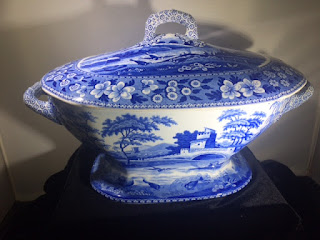And then there was the day I discovered a soup tureen on eBay for a surprisingly small opening bid. I looked at the pictures and saw the mark on the back. I remembered seeing a page in my go-to reference book Antique Blue and White Spode with a table of back markings and their dates, so I looked it up and, to my surprise, found it to be "perhaps the earliest marking"! Needless to say, I placed my bid right then, thrilled at the thought of owning a real antique piece of Spode! To my great disappointment, I was outbid. I watched the item until the end, though, when, quite dramatically and at the very last second, I placed another bid and won it back! I later found out that it dates from 1800-1820, during an era in which such historical events as the Battle of Waterloo and the War of 1812 were taking place.
The excitement of actually owning a piece of antique Spode spurred me to do some research as well as to do some practical thinking about the pros and cons of antique versus new Spode dishes.
The benefit of the antiques is mostly that of being able to hold in your hands a real piece of history, which has been held and used and cared for by the hands of generation after generation of people who lived through events and times we can only study about. It is even more meaningful if you happen to know about the prior owners of your Spode.
 I have often wished there were a way to find out something about the people who owned my soup tureen, and have wondered whether the hands that washed it belonged to a servant or housewife, whether it stood on a grand mahogany dining table or on a rough wooden kitchen table. I wonder whether it was ordered by an American who sent a letter that crossed the seas to England, or whether it was brought over with an immigrant family as treasured possession. Did it have pride of place in a hutch or Welsh dresser, or was it just another dish? If you have an active imagination with a historical bent, these are the thoughts antique dishes inspire.
I have often wished there were a way to find out something about the people who owned my soup tureen, and have wondered whether the hands that washed it belonged to a servant or housewife, whether it stood on a grand mahogany dining table or on a rough wooden kitchen table. I wonder whether it was ordered by an American who sent a letter that crossed the seas to England, or whether it was brought over with an immigrant family as treasured possession. Did it have pride of place in a hutch or Welsh dresser, or was it just another dish? If you have an active imagination with a historical bent, these are the thoughts antique dishes inspire.However, if your love of transferware comes with more of a practical mindset, then new Spode might be for you. These dishes are dishwasher and microwave safe and, like their older counterparts, are quite sturdy. Thus, you can have the look and quality of antique dishes with all the modern convenience of new dishes.
I suppose that's one reason why I love these Spode dishes so much: they are timeless classics, but still produced. I chose new Spode plates for my every day dishes because I knew they were replaceable if broken, and the older pieces I have are special because of their age, but they are of such good quality, I can actually use them just as I would newer dishes.

No comments:
Post a Comment